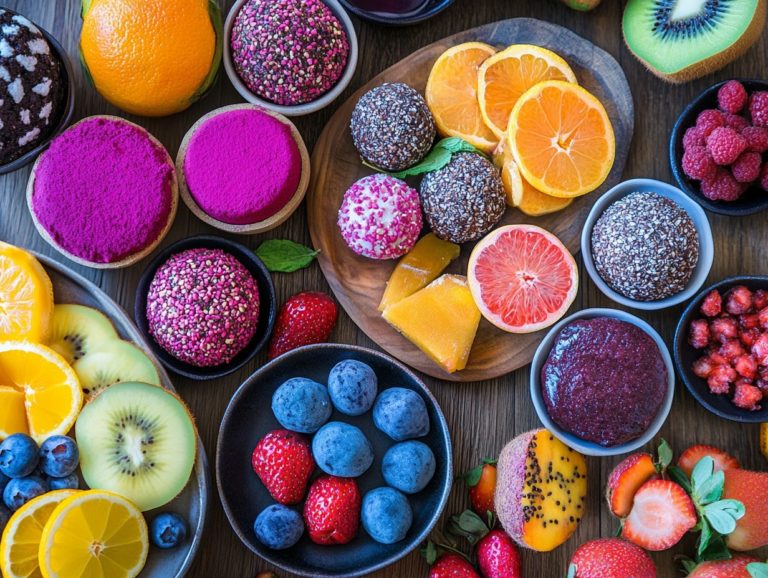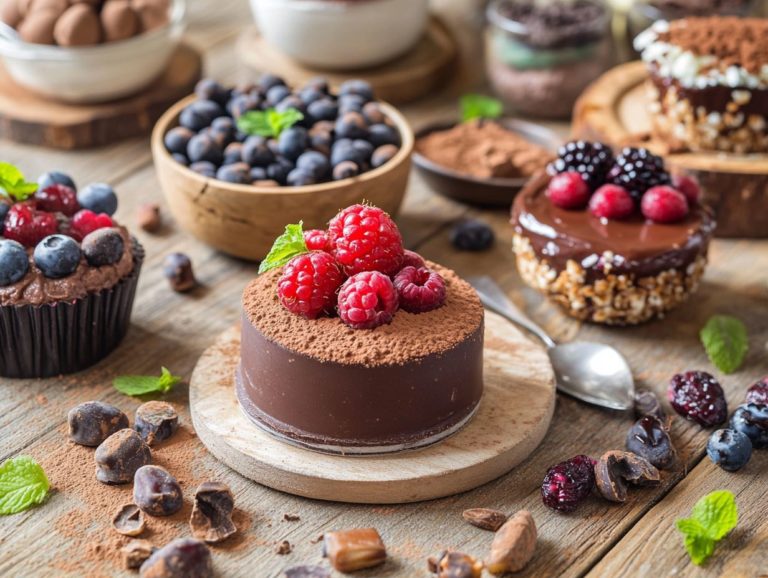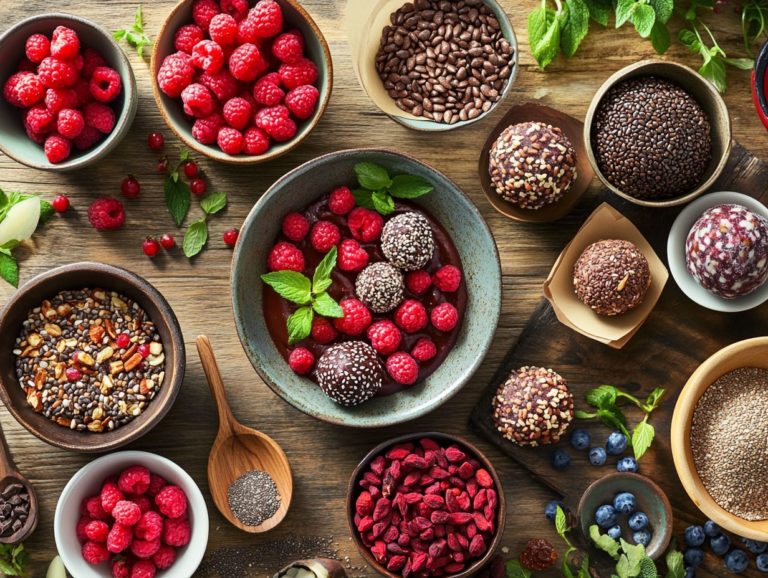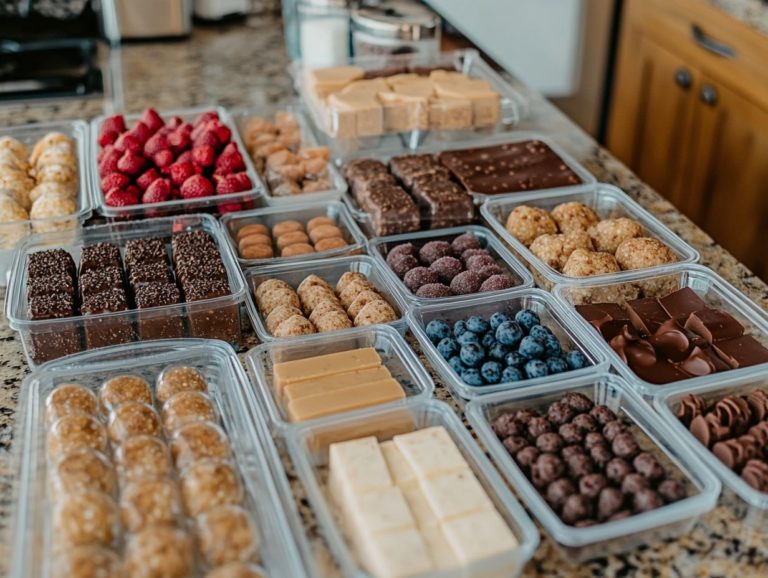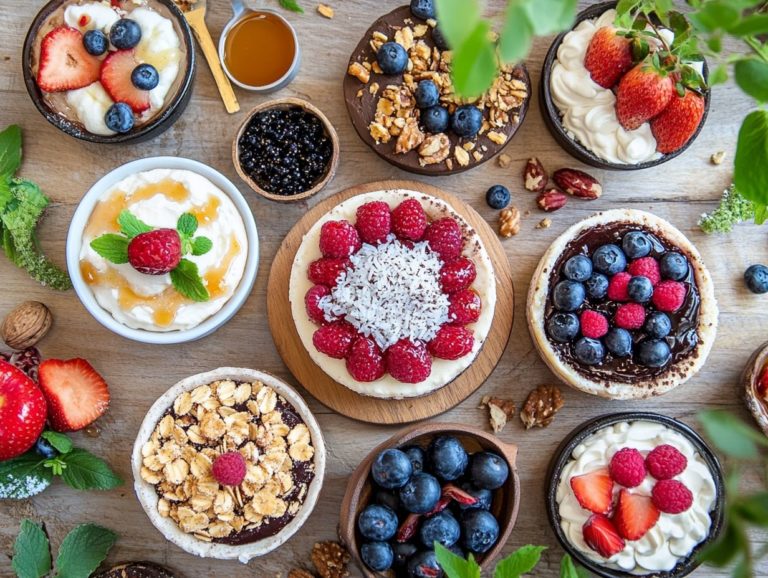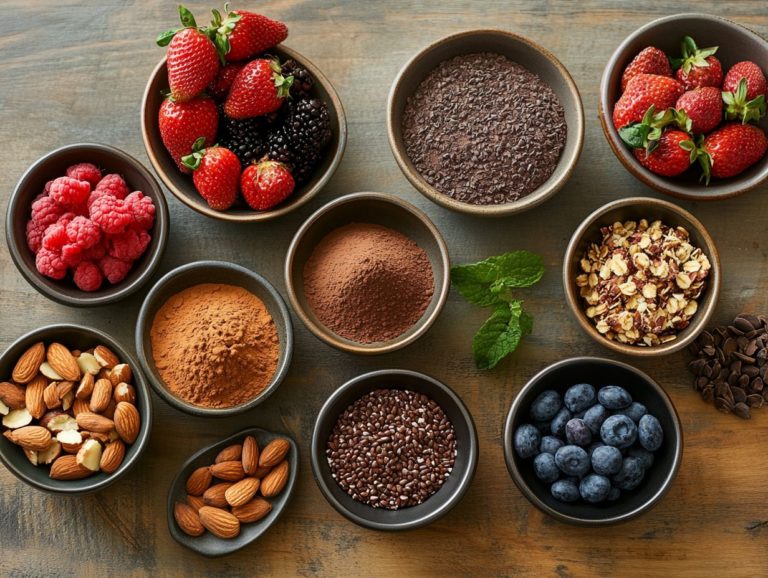The Art of Plating Raw Desserts
Plating raw desserts transcends mere food service; it transforms into an art form that elevates your entire dining experience.
From the vibrant hues to the delicate textures, the way you present these sweet masterpieces significantly influences their allure. This discussion delves into the essentials of raw dessert plating, highlighting the significance of aesthetics, the key elements that contribute to a stunning presentation, and the tools that simplify the process. These insights are invaluable for your recipe development and cookbook projects.
Whether you re gearing up for a casual get-together or orchestrating a formal event, mastering the art of plating will turn your desserts into breathtaking centerpieces that leave a lasting impression. With proper plating techniques, even savory ingredients in desserts can surprise your guests.
Contents
- Key Takeaways:
- What Is Raw Dessert Plating?
- Why Is Plating Important in Raw Desserts?
- What Are the Basic Tools for Plating Raw Desserts?
- How to Create a Balanced and Harmonious Plate?
- Elevating the Visual Appeal of Raw Desserts
- What Are the Common Mistakes in Plating Raw Desserts?
- How to Plate Raw Desserts for Different Occasions?
- Tips for Plating Raw Desserts Like a Pro
- 3. Pay Attention to Details
- Frequently Asked Questions
- Can I pre-order raw dessert books?
- What is the art of plating raw desserts?
- Why is plating important in raw desserts?
- What are some key elements to consider when plating raw desserts?
- Do you need special tools to plate raw desserts?
- Can I use edible flowers in my plated raw desserts?
- What are some tips for beginners when plating raw desserts?
Key Takeaways:
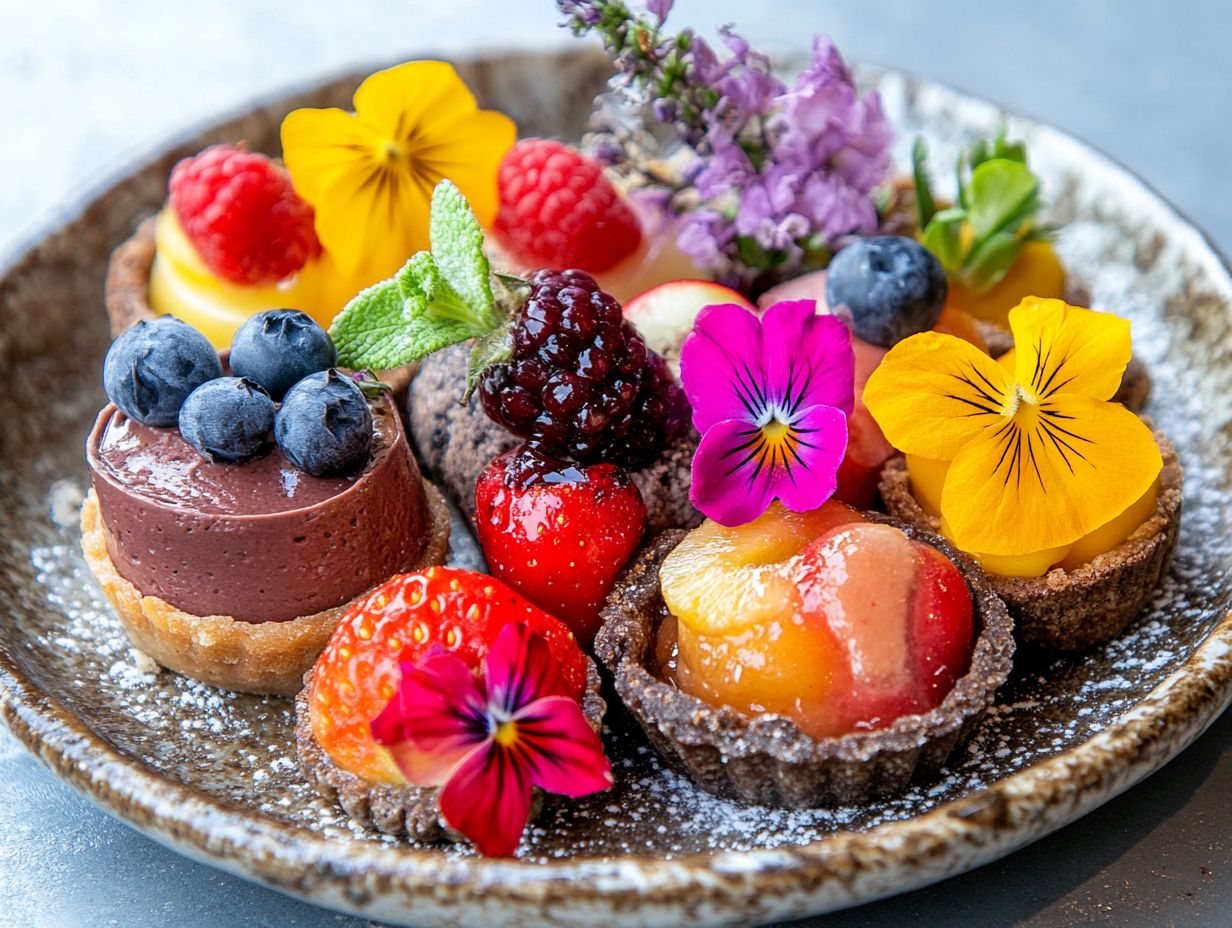
- Plating is an essential aspect of presenting raw desserts, enhancing their visual appeal and adding to the overall dining experience.
- A well-plated raw dessert should have a balance of elements such as color, texture, height, and attention to detail.
- To plate like a pro, use fresh and seasonal ingredients, create height and dimension, and pay attention to details for a visually appealing and harmonious presentation.
What Is Raw Dessert Plating?
Raw dessert plating is a captivating art form that transforms your delectable raw desserts into visually stunning masterpieces, showcasing the cooking skills of both chefs and enthusiasts. The process often involves the intricate art of recipe writing and the creative flavors that define each dish.
By employing thoughtful plating techniques think geometric shapes and decorative edible elements you can elevate the presentation of unique recipes like the Three-Layer Tiramisu Cake and Blackberry Ginger Lime Zebra Cheesecake. This meticulous process not only enhances the visual allure but also invites you to immerse yourself in the delightful world of raw cuisine and its inventive flavors.
As exemplified by renowned chefs such as Maria Vittoria Griffoni from the Raw Food Culinary Academy and Jovanotti from PepeNero Bistrot, mastering the art of plating is crucial. This skill enhances the overall perception and enjoyment of raw desserts.
Why Is Plating Important in Raw Desserts?
Plating plays a pivotal role in raw desserts, shaping first impressions and enhancing the overall dining experience. When you present a beautifully plated dessert, it not only catches the eye but also elevates taste perception, showcasing the innovative flavors and textures of the dish. This is a key aspect of cuisine presentation that should not be overlooked.
Elements like color contrast and arrangement are essential in dessert presentation, making it imperative for you to master cooking techniques that resonate with your culinary vision. Consider taking an online course to hone your skills further.
For instance, layering vibrant fruits with creamy textures can create a stunning visual contrast that captivates your diners while enriching the depth of flavors. Techniques such as drizzling sauces or adorning your creations with edible flowers can significantly elevate the aesthetic appeal and emotional connection to the dish, ensuring it lingers in memory.
Keep in mind that the psychology of plating has a powerful effect on how diners anticipate their experience; a thoughtfully arranged dessert can ignite excitement and curiosity, transforming an ordinary meal into an engaging culinary adventure.
Imagine the delight on your guests’ faces when they see your stunning creations! Don’t miss the chance to impress your guests! Start mastering these techniques today!
What Are the Elements of a Well-Plated Raw Dessert?
A well-plated raw dessert should encompass several key elements that enhance both its aesthetic and sensory appeal. These elements craft a memorable culinary experience. You ll want to employ layering techniques to build texture and use contrasting colors to catch the eye.
Arranging components thoughtfully guides the viewer s gaze. Adding edible garnishes can elevate your presentation and transform each dessert into something not only delicious but also visually stunning.
For instance, when preparing a raw chocolate mousse, consider creating a rich, dark layer topped with a lighter, airy coconut cream. This combination creates a delightful contrast that excites the palate.
Similarly, in a layered berry parfait, alternating the vibrant hues of mixed berries with creamy cashew-based layers results in an inviting visual play.
You can emphasize focal points by crowning the dessert with a single edible flower or a sprinkle of crushed nuts. This adds a textural element and draws the eye toward the centerpiece of the dish.
By thoughtfully applying balance, contrast, and focal points, you ensure that each dessert resonates with flavor while captivating the senses visually.
What Are the Basic Tools for Plating Raw Desserts?
To master the art of plating raw desserts, a selection of essential tools is crucial for both chefs and home cooks. These tools ensure that your final presentation is as visually stunning as it is delicious.
Key items include:
- Ring molds for crafting elegant geometric shapes,
- Squeeze bottles for precise application of sauces,
- Offset spatulas for meticulous arrangement of components.
These tools elevate the look of your desserts and help you showcase impressive techniques. They make your dishes irresistibly camera-ready for those enticing food photography moments.
Capturing these moments beautifully can be added to your cookbook.
What Are the Different Types of Plates Used for Plating Raw Desserts?
The type of plate you choose for raw dessert plating plays a pivotal role in how the overall presentation comes together. It elevates your culinary experience.
The style of the plate whether flat, deep, or textured can significantly affect how each dessert is perceived. This often reflects the theme of the dish or your unique style as a chef.
For example, a sleek white plate beautifully highlights the vibrant colors of a Chocolate Mousse Cake or a Pecan Pie with Rosemary and Orange. Meanwhile, textured plates add an intriguing layer of interest to your presentation.
Opting for a deep plate might be your best bet for layered desserts. It allows diners to appreciate the intricate details and textures that make up the dish.
Conversely, a wide, shallow plate creates a striking visual impact for minimalist desserts, making them appear more expansive and inviting.
Each plate serves its functional purpose, but it also influences the overall dining experience. It subtly guides your guests’ emotions and expectations.
For example, the selection of plates can complement delicious vegan recipes in your repertoire.
By aligning your plating style with the essence of the dessert, you create a cohesive dining experience. This invites your guests to savor not just the aesthetic appeal but also the delightful flavors that await them.
This alignment is especially important in dessert presentations involving unique recipes like the Banana Cream Pie with Gingerbread Crust or Mocha Donuts.
How to Create a Balanced and Harmonious Plate?
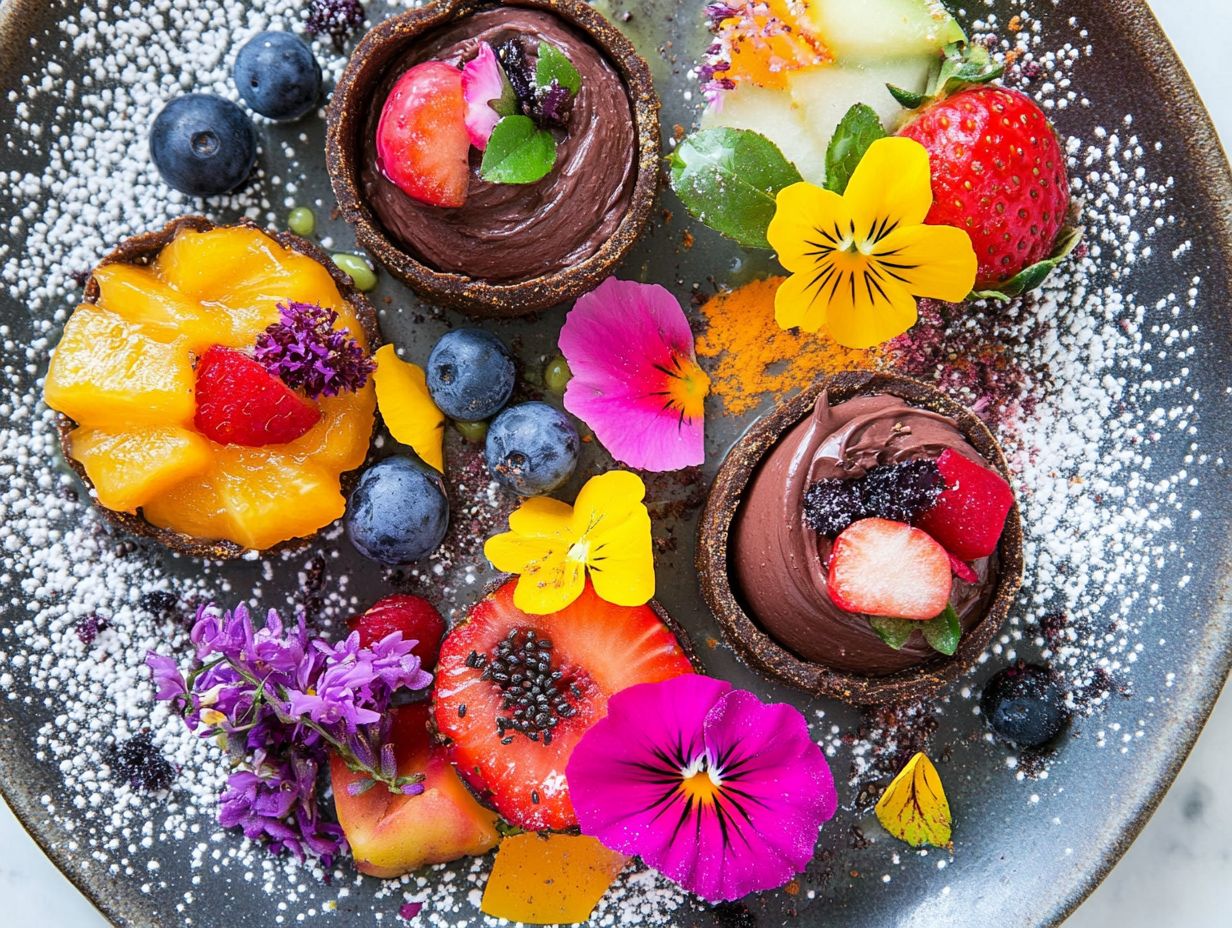
Creating a balanced and harmonious plate is essential for achieving an alluring raw dessert presentation. This captivates attention and delights the palate.
This involves not only plating techniques but also the thoughtful integration of creative flavors and challenging projects that push the boundaries of raw cuisine.
To accomplish this, you should consider key elements like color harmony, component balance, and textural contrast. Each contributes to the overall visual appeal.
Furthermore, by incorporating creative flavors and arranging your dessert components in an eye-catching manner such as through layering you can elevate the sensory experience.
This makes each bite even more enjoyable.
Elevating the Visual Appeal of Raw Desserts
1. Consider the Visual Appeal
The visual appeal of a raw dessert is paramount it s often the first thing that captures your attention. By employing strategic plating techniques, such as carefully arranging layers and using contrasting colors, you can create a presentation that is not only stunning but also enhances the overall culinary experience. Each element should work in harmony to guide your eye and elevate the dessert’s allure.
Color plays a crucial role in this visual journey; for instance, vibrant fruits can provide a refreshing pop, while deep chocolate hues evoke a sense of indulgence. Texture adds another exciting layer; imagine a raw cheesecake topped with velvety cashew cream contrasted against crunchy nuts, creating a delightful sensory experience.
Thoughtful composition balancing height, shape, and negative space (the empty area around the food that emphasizes its beauty) ensures that every element draws you in. Take a well-styled acai bowl, for example; its rich purples and artfully sprinkled toppings not only look appetizing but also whisper promises of healthful indulgence. In this way, the harmony of these factors significantly influences how you perceive raw desserts. This principle can also be applied to other desserts, ensuring that each dish is not only delicious but also visually appealing.
2. Play with Colors and Textures
Playing with colors and textures is essential when it comes to plating raw desserts. It s the secret ingredient that can elevate an ordinary dish into an extraordinary tasty treat! By incorporating a variety of textures smooth, crunchy, and creamy along with a vibrant color palette, you can craft an enticing visual display that intrigues and excites the palate. This dynamic interplay invites your diners to fully appreciate the creative flavors nestled within each layered dessert.
Picture a raw berry cheesecake, where the creamy filling is beautifully accented by a vivid raspberry coulis, providing both color and a tangy contrast. Imagine topping it off with a sprinkle of crushed nuts; this addition not only introduces a delightful crunch but also brings in earthy tones that ground the dish. This approach can also be applied to desserts like Vanilla Bean Gelato served with a Shortbread Base or a Miso Cr me Br l e to add an element of surprise and delight.
Envision a raw chocolate mousse elegantly garnished with bright orange zest and chia seeds. This garnish adds a pop of color and an extra texture that harmonizes beautifully with the rich, velvety chocolate base. By thoughtfully combining these elements, you’re not just enhancing the visual allure of your raw desserts; you re also elevating the overall dining experience for everyone at the table. Consider using Fresh Fruit like berries or slices of Vanilla Bean Gelato to add further layers and dimensions to your raw dessert creations!
3. Use Different Plating Techniques
Utilizing a variety of plating techniques is essential to achieve stunning raw dessert presentations that leave a lasting impression. Techniques like layering dessert components can add depth and intrigue, while drizzling sauces or employing molds can create intricate designs that elevate the dish s visual appeal. Thoughtful plating enhances the entire culinary experience, making each dessert more irresistible for food photography enthusiasts.
Experimenting with different styles perhaps a minimalist approach that uses negative space to highlight the beauty of each element or the bold splash technique that combines colors and textures in vibrant hues and contrasting patterns can lead to memorable presentations. For example, envision a raw chocolate ganache tart elegantly surrounded by a vibrant raspberry coulis; this captivating contrast will surely entice the eye.
Don t overlook the finishing touches! Garnishing with edible flowers or microgreens can add a fresh and artistic flair, transforming simple raw desserts into remarkable masterpieces that not only delight the palate but also wow onlookers. This underscores the significant role of creativity and precision in the art of plating, much like the attention to detail seen in Perfect Pastries and Cookies.
What Are the Common Mistakes in Plating Raw Desserts?
When you re plating raw desserts, it s crucial to avoid a few common mistakes that can compromise the overall presentation. These mistakes can diminish the culinary experience for your guests. Overcrowding the plate, overlooking color contrast, and neglecting clean lines and symmetry are errors that can easily detract from your efforts. Recognizing and steering clear of these pitfalls ensures that each dessert delights the palate while captivating the eye.
To elevate the aesthetic of your dessert plating, consider embracing negative space. This refers to areas of the plate that are left empty, which can make the food stand out and lend a sophisticated elegance to your presentation. Incorporating a variety of textures such as pairing crunchy elements with creamy or soft components can add depth and intrigue, making the dish even more appealing.
Don t shy away from experimenting with plate shapes; placing a round dessert on a square plate creates a striking contrast that enhances visual impact. Ultimately, taking the time to thoughtfully arrange each element beautifies the dish and enriches the overall dining experience for everyone at the table. For inspiration, look to the artistry seen at PepeNero Bistrot or insights from the Raw Food Culinary Academy.
How to Plate Raw Desserts for Different Occasions?
Plating raw desserts for various occasions calls for a keen understanding of the context and audience. This allows you to tailor the presentation to enrich the overall culinary experience.
Whether you’re preparing for a casual gathering, an elegant dinner, or a special celebration, your approach to dessert presentation should resonate with the nature of the event, while highlighting the dish’s creative flavors. By employing unique plating techniques, you can elevate even the simplest raw dessert. Consider creating a raw dessert platter for parties to ensure it leaves a memorable impression that lingers long after the last bite.
1. Casual Gatherings
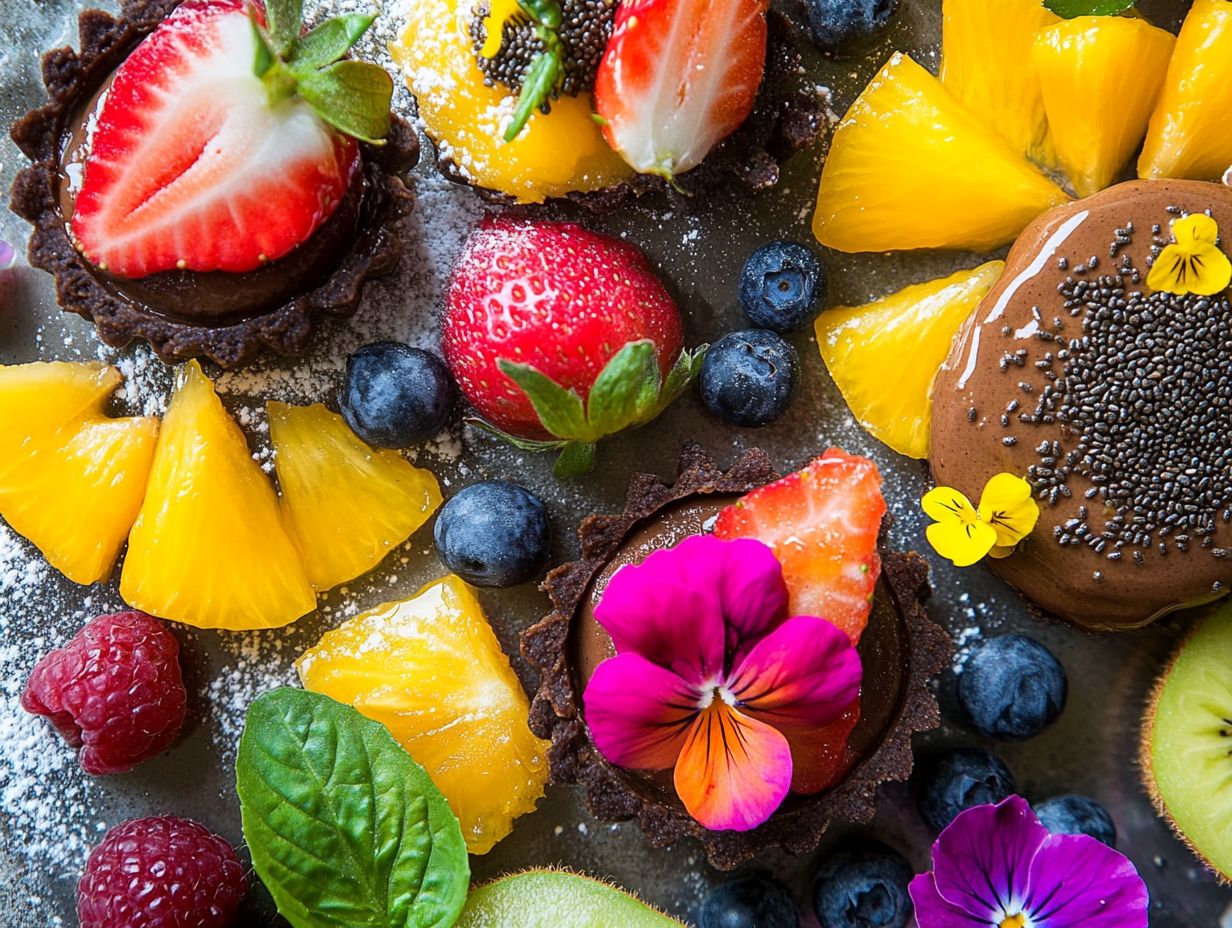
Adopt a fun and creative approach to plating that will wow your guests! For your casual gatherings, you can use unique recipes and straightforward plating techniques to craft inviting presentations that beckon your guests to indulge.
Consider incorporating playful elements like family-style servings or interactive dessert stations. These can elevate the experience and leave a lasting impression on everyone. One effective strategy is to utilize vibrant, colorful ingredients that grab attention, such as sliced fruits, edible flowers, or drizzles of rich raw chocolate sauce.
Instead of serving individual plates, think about presenting a large platter that showcases bite-sized portions of raw treats like bliss balls or mini cheesecakes. These are not only easy to share, but they also foster a communal vibe.
You might even consider setting up a raw dessert bar where guests can customize their toppings or choose their favorite flavors. This can ignite conversation and cater to various dietary preferences. Integrating a dessert like the Blackberry Ginger Lime Zebra Cheesecake or Banana Cream Pie with Gingerbread Crust can provide unique and memorable options for your guests.
Ultimately, your goal is to achieve a perfect balance between aesthetics and accessibility, ensuring that everyone feels welcome to partake in the delicious experience you ve created. Don’t miss out on the chance to impress your guests with stunning presentations!
Try these plating tips at your next gathering and see the difference!
2. Formal Dinners
When you plate raw desserts for formal dinners, paying attention to detail is absolutely crucial for achieving an elegant and sophisticated presentation. By employing refined plating techniques think layering and strategic garnishing you can elevate the visual appeal of your dessert, transforming it into a standout feature of the dining experience. Each component should be arranged with meticulous care to complement the creative flavors and create a harmonious composition on the plate, similar to the precision required in crafting a Three-Layer Tiramisu Cake or Chocolate Mousse Cake.
To craft a truly impressive display, consider incorporating textured elements like crushed nuts or edible flowers to introduce dimension and color. For added impact, experimenting with components like Heavenly Chocolate or Tiramisu can enhance the sophistication of your presentation. Using contrasting colors can further enhance the aesthetic; for example, pairing a velvety chocolate mousse with vibrant raspberry coulis produces a striking visual contrast.
Stacking elements, such as fruit tarts layered with creamy coconut filling, not only adds height but also draws the diner’s eye toward the center of the plate. Drizzling sauces with artistic flair and incorporating thoughtful garnishments like mint leaves or citrus zest can elevate the elegance of your presentation, transforming each dessert into not just a dish, but a true celebration on the table.
3. Special Celebrations
For your special celebrations, the artistry of raw dessert plating should truly embody the significance and joy of the occasion. Drawing inspiration from notable events like a 12 days of silent meditation retreat or even the elegance of a Crystal gala can elevate your presentations.
Think about incorporating unique recipes and visually striking presentations that captivate the senses. By utilizing vibrant colors, intricate designs, and thematic elements, you can elevate the dessert to a stunning centerpiece that enhances the overall festive atmosphere. Adding special touches, such as personalized garnishes or exceptional plating styles, will help create lasting memories for your guests.
To further elevate the raw dessert experience, consider integrating seasonal fruits, edible flowers, or even themed sprinkles that resonate with the celebration’s vibe. For example, at a birthday party, imagine a rich chocolate avocado mousse adorned with an array of vividly colored berries artfully arranged in a playful pattern. Meanwhile, a wedding celebration could be graced with a layered cashew cheesecake, elegantly topped with delicate edible florals.
Including thoughtful elements like custom dessert tags or a unique serving dish introduces a personal touch, transforming simple treats into unforgettable highlights that allow your guests to revel in the delicious elegance crafted just for them.
Tips for Plating Raw Desserts Like a Pro
To plate raw desserts like a professional, there are several key tips that can truly elevate your presentation and leave a lasting impression on your guests.
First and foremost, prioritize fresh and seasonal ingredients; they not only enhance the flavor profile but also significantly boost the visual allure of your dish. Furthermore, consider creating height and dimension by layering components and varying their sizes. This approach will infuse a dynamic quality into your dessert presentation, making it as delightful to behold as it is to savor.
Fresh and Seasonal Ingredients for Stunning Desserts
Using fresh and seasonal ingredients is essential for crafting stunning raw dessert presentations that truly showcase the dish’s natural beauty and flavor. Consider inspiration from renowned chefs like Maria Vittoria Griffoni or techniques used in iconic establishments such as PepeNero Bistrot.
These ingredients not only enhance the taste but also bring vibrant colors and textures that create a striking visual impact on the plate. Aim to feature local produce and seasonal fruits that harmonize with the creative flavors of your unique recipes.
Incorporating elements like ripe berries in the summer or squash in the fall allows you to celebrate the season while elevating the overall dining experience. Imagine your guests delighting in desserts adorned with vibrant seasonal flowers or garnished with bright, locally-sourced fruit. This sparks joy and curiosity, inviting them to savor each bite even more.
For example, a dessert featuring fresh peach slices or a drizzle of homemade berry coulis offers a delightful contrast in flavor while captivating the eye. This connection between sourcing fresh ingredients and creating visually appealing dishes ultimately crafts a memorable experience that delights all the senses, much like the exquisite presentations offered by Maria Vittoria Griffoni at the Raw Food Culinary Academy.
Creating Height and Dimension in Raw Desserts
Creating height and dimension in your plating is an essential technique for raw desserts that can truly elevate their visual appeal. By stacking elements, layering components, or using different serving vessels, you can craft a sense of movement and drama on the plate.
This technique enhances the aesthetic while adding an exhilarating element to the dining experience, encouraging diners to explore each layer of flavor. This approach aligns with techniques taught at the Raw Food Culinary Academy.
Take, for example, a raw Blackberry Ginger Lime Zebra Cheesecake with a nut crumble base topped by a creamy cashew mixture and crowned with a vibrant berry coulis. This vertical arrangement invites diners to dig in, revealing unexpected textures and tastes with every forkful.
Similarly, consider a parfait made with layers of chia pudding, coconut cream, and fresh fruits. This delightful creation showcases varied colors and heights, playfully enticing the palate. Another example is a Banana Cream Pie with Gingerbread Crust, where the layers offer a delightful combination of flavors and textures.
You might also experiment with cylinder molds that promote verticality or utilize large plates to create the illusion of spaciousness in desserts like a deconstructed Tiramisu served in a glass. Each method offers a unique canvas, transforming your desserts into delightful masterpieces that captivate and satisfy. Consider adding elements like Miso Cr me Br l e or Chocolate Mousse Cake to elevate your presentation.
3. Pay Attention to Details
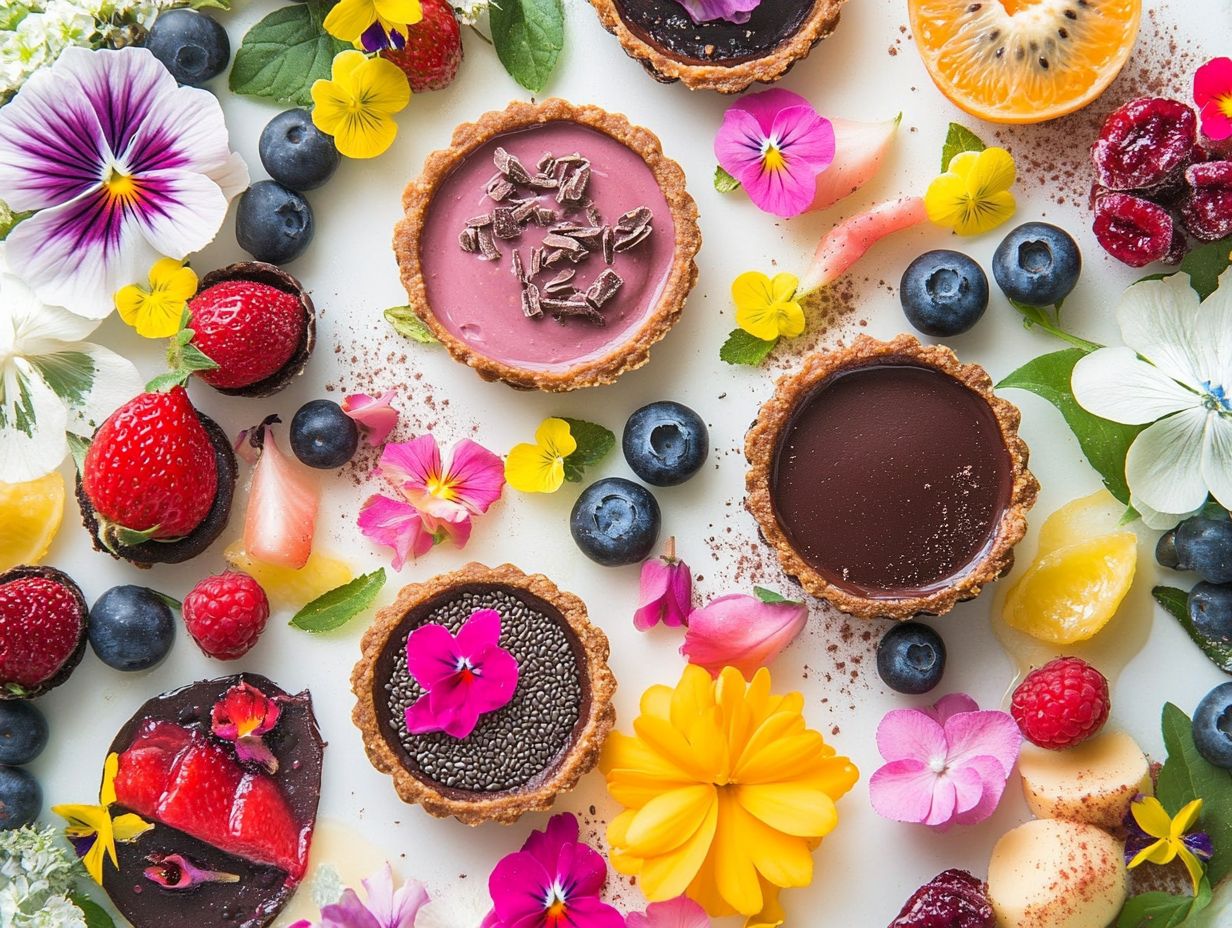
Attention to detail is essential when plating raw desserts. Even the tiniest elements can significantly impact the overall presentation. From selecting the perfect garnishes to ensuring clean lines and symmetry, every aspect deserves your thoughtful consideration to achieve a polished look. This level of meticulousness not only enhances the visual appeal but also elevates the culinary experience of the dish.
Techniques honed during the writing process can also apply here to ensure precision and artistry. For example, a simple raw chocolate mousse can be transformed by serving it in a sleek glass. A few fresh berries artfully arranged on top will instantly elevate your dessert presentation!
Employ techniques like artfully drizzling a complementary sauce or sprinkling crushed nuts around the base to create an inviting atmosphere. Incorporating Vanilla Bean Gelato or creating a Three-Layer Tiramisu Cake will add an indulgent touch.
Utilizing contrasting shapes and sizes can enhance depth and interest. A tall, cylindrical dessert paired with flat elements makes for a dynamic plate. Incorporating edible flowers not only injects a splash of color but also introduces a fresh taste. By focusing on these finer details, you ensure a memorable presentation that delights the senses. For instance, a Pecan Pie with Rosemary and Orange can be paired with flat pastries to create a visually appealing contrast. Explore creativity in raw dessert presentations for more inspiration.
Video by Maria Vittoria Griffoni and Jovanotti, published on December 6th 2022
Frequently Asked Questions
Can I pre-order raw dessert books?
Yes, you can pre-order various raw dessert books to explore more recipes and techniques.
What is the art of plating raw desserts?
The art of plating raw desserts involves arranging and presenting uncooked, plant-based desserts in a visually appealing and creative manner. This can be seen in the elegant presentations at PepeNero Bistrot.
Why is plating important in raw desserts?
Plating enhances the overall dining experience by stimulating the senses and creating an aesthetically pleasing presentation.
What are some key elements to consider when plating raw desserts?
Key elements to consider when plating raw desserts include color, texture, height, and balance. These elements work together to create a visually appealing and well-balanced dish. Incorporating desserts like Mocha Donuts or a Shortbread Base can significantly enhance the aesthetic.
Do you need special tools to plate raw desserts?
No, you don’t need special tools to plate raw desserts. However, having a variety of small spatulas, tweezers, and pastry brushes can help with precise placement and decoration.
Can I use edible flowers in my plated raw desserts?
Yes, edible flowers can add a beautiful touch to plated raw desserts. Just make sure to research which flowers are safe to eat and wash them properly before use.
What are some tips for beginners when plating raw desserts?
For beginners, some tips when plating raw desserts include practicing with different plate sizes and shapes, using contrasting colors and textures, and paying attention to details such as sauce drizzles and garnishes. Exploring recipes from Perfect Pastries and Cookies can provide valuable insights.
Ready to try plating your own raw desserts? Watch the video above for a practical demonstration!

